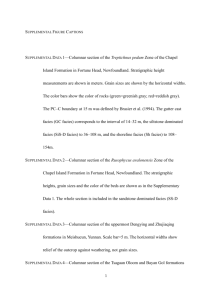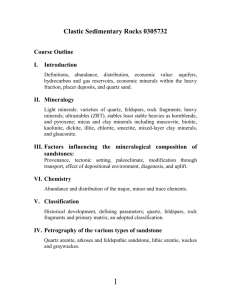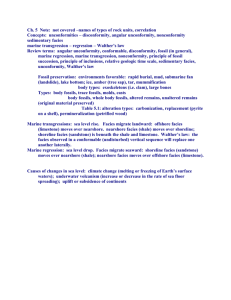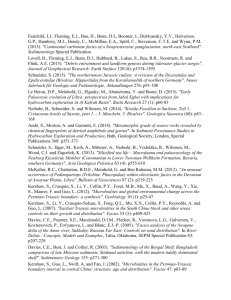Sedimentology: Process and Product.
advertisement
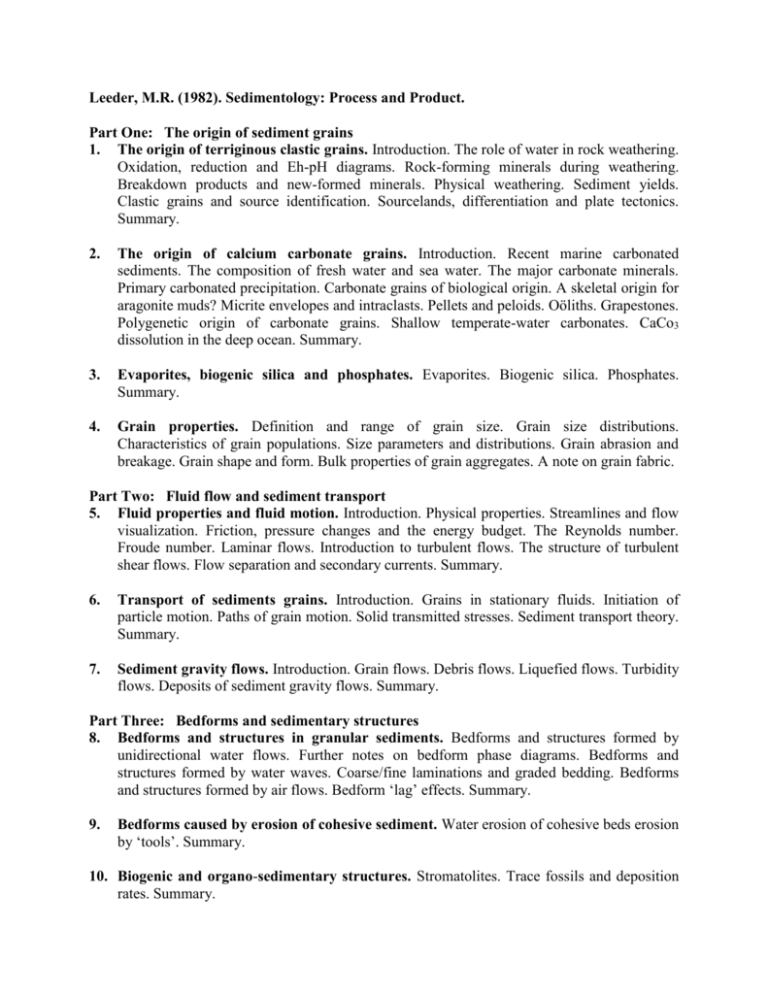
Leeder, M.R. (1982). Sedimentology: Process and Product. Part One: The origin of sediment grains 1. The origin of terriginous clastic grains. Introduction. The role of water in rock weathering. Oxidation, reduction and Eh-pH diagrams. Rock-forming minerals during weathering. Breakdown products and new-formed minerals. Physical weathering. Sediment yields. Clastic grains and source identification. Sourcelands, differentiation and plate tectonics. Summary. 2. The origin of calcium carbonate grains. Introduction. Recent marine carbonated sediments. The composition of fresh water and sea water. The major carbonate minerals. Primary carbonated precipitation. Carbonate grains of biological origin. A skeletal origin for aragonite muds? Micrite envelopes and intraclasts. Pellets and peloids. Oöliths. Grapestones. Polygenetic origin of carbonate grains. Shallow temperate-water carbonates. CaCo3 dissolution in the deep ocean. Summary. 3. Evaporites, biogenic silica and phosphates. Evaporites. Biogenic silica. Phosphates. Summary. 4. Grain properties. Definition and range of grain size. Grain size distributions. Characteristics of grain populations. Size parameters and distributions. Grain abrasion and breakage. Grain shape and form. Bulk properties of grain aggregates. A note on grain fabric. Part Two: Fluid flow and sediment transport 5. Fluid properties and fluid motion. Introduction. Physical properties. Streamlines and flow visualization. Friction, pressure changes and the energy budget. The Reynolds number. Froude number. Laminar flows. Introduction to turbulent flows. The structure of turbulent shear flows. Flow separation and secondary currents. Summary. 6. Transport of sediments grains. Introduction. Grains in stationary fluids. Initiation of particle motion. Paths of grain motion. Solid transmitted stresses. Sediment transport theory. Summary. 7. Sediment gravity flows. Introduction. Grain flows. Debris flows. Liquefied flows. Turbidity flows. Deposits of sediment gravity flows. Summary. Part Three: Bedforms and sedimentary structures 8. Bedforms and structures in granular sediments. Bedforms and structures formed by unidirectional water flows. Further notes on bedform phase diagrams. Bedforms and structures formed by water waves. Coarse/fine laminations and graded bedding. Bedforms and structures formed by air flows. Bedform ‘lag’ effects. Summary. 9. Bedforms caused by erosion of cohesive sediment. Water erosion of cohesive beds erosion by ‘tools’. Summary. 10. Biogenic and organo-sedimentary structures. Stromatolites. Trace fossils and deposition rates. Summary. 11. Soft sediment deformation structures. Reduction of sediment strength. Liquefaction and water escape structures. Liquefaction and differential loading structures. Slides, growth faults and slumps. Desiccation and syneresis shrinkage structures. Summary. Part Four: Environmental and facies analysis 12. Environmental and facies analysis. Scope and philosophy. Depositional systems and facies. Succession, preservation and analysis. Subsidence, uplift and deposition. Transgression, regression and diachronism. Palaeocurrents. The Holocene. Basin analysis and plate tectonics. Summary. Part Five: Continental environments and facie analysis 13. Deserts. Introduction. Physical processes and erg formation. Modern desert facies. Ancient desert facies. Summary. 14. Alluvial fans. Introduction. Physical processes. Modern facies. Ancient alluvial fan facies. Summary. 15. River plains. Introduction. Physical processes. Modern river plain facies. Ancient river plain facies. Summary. 16. Lakes. Introduction. Physical and chemical processes. Modern lake facies. Ancient lake facies. Summary. 17. Glacial environments. Introduction. Physical processes. Pleistocene and modern glacial facies. Ancient glacial facies. Summary. Part Six: Coastal and shelf environments and facies analysis 18. Physical processes of coast and shelf. Introduction. Wind-generated waves. Tides and tidal waves. Summary. 19. Deltas. Introduction. Physical processes. Modern deltaic facies. Ancient deltaic facies. Summary. 20. Estuaries. Introduction. Estuarine dynamics. Modern estuarine facies. Ancient estuarine facies. Summary. 21. ‘Linear’ clastic shorelines. Introduction. Physical processes. Recent facies of linear clastic shorelines. Ancient clastic shoreline facies. Summary. 22. Clastic shelves. Introduction. Shelf dynamis. Recent shelf facies. Ancient clastic shelf facies. Summary. 23. Carbonate-evaporite shorelines, shelves and basins. Introduction. Arid tidal flats and sabkhas. Humid tidal flats and marshes. Lagoons and bays. Tidal delta and spillover oölite sands. Open carbonate shelves. Platform margin reefs and buildups. Platform margin slopes and basins. Sub-aqueous evaporites. Summary. Part Seven: Oceanic environments and facies analysis 24. Oceanic processes. Introduction. Physical processes. Chemical and biochemical processes. Surface currents and circulation. Structure, deep currents and circulation. Slumps, debris flow and turbidity currents. Palaeo-oceanography. Summary. 25. Clastic oceanic environments. Introduction. Continental slopes and rises of passive margins. Submarine fans and cones. Abyssal plains. Trenches and fore-arc basins of active margins. Summary. 26. Pelagic oceanic sediments. Sediment types. Oceanic facies successions. Anoxic oceans and oceanic events. Hypersaline oceans. Continental outcrops of ancient facies. Summary. Part Eight: Diagenesis: sediment into rock 27. Diagenesis: general considerations. Definitions. Subsurface pressure and temperature. Petrography in diagenetic studies. Stable isotopes in diagenetic studies. Eh-pH phase diagrams in diagenetic studies. Compaction and fluid migration. Pressure solution. Diagenetic realms. Summary. 28. Terrigenous clastic sediments. Introduction. Marine mud diagenesis. Non-marine mud diagenesis. Classification of mudrocks. Near-surface sand diagenesis. Secondary porosity and sandstone diagenesis. Classification. 29. Carbonate sediments. Introduction. Early meteoric diagenesis. Early marine diagenesis. Subsurface diagenesis by formation waters. Summary of limestone diagenesis. Models for dolomitisation. Classification. Summary. 30. Evaporites, silica, iron and manganese. Evaporites. Silica diagenesis. Iron minerals. Manganese. Summary. 31. Hydrocarbons. Introduction. Coal composition and rank. Coal-forming environments. Oil and gas-organic matter, source rock and diagenesis. Oil and gas migration. Oil and gas traps and reservoir studies. Tar sands. Oil shales. Summary.


